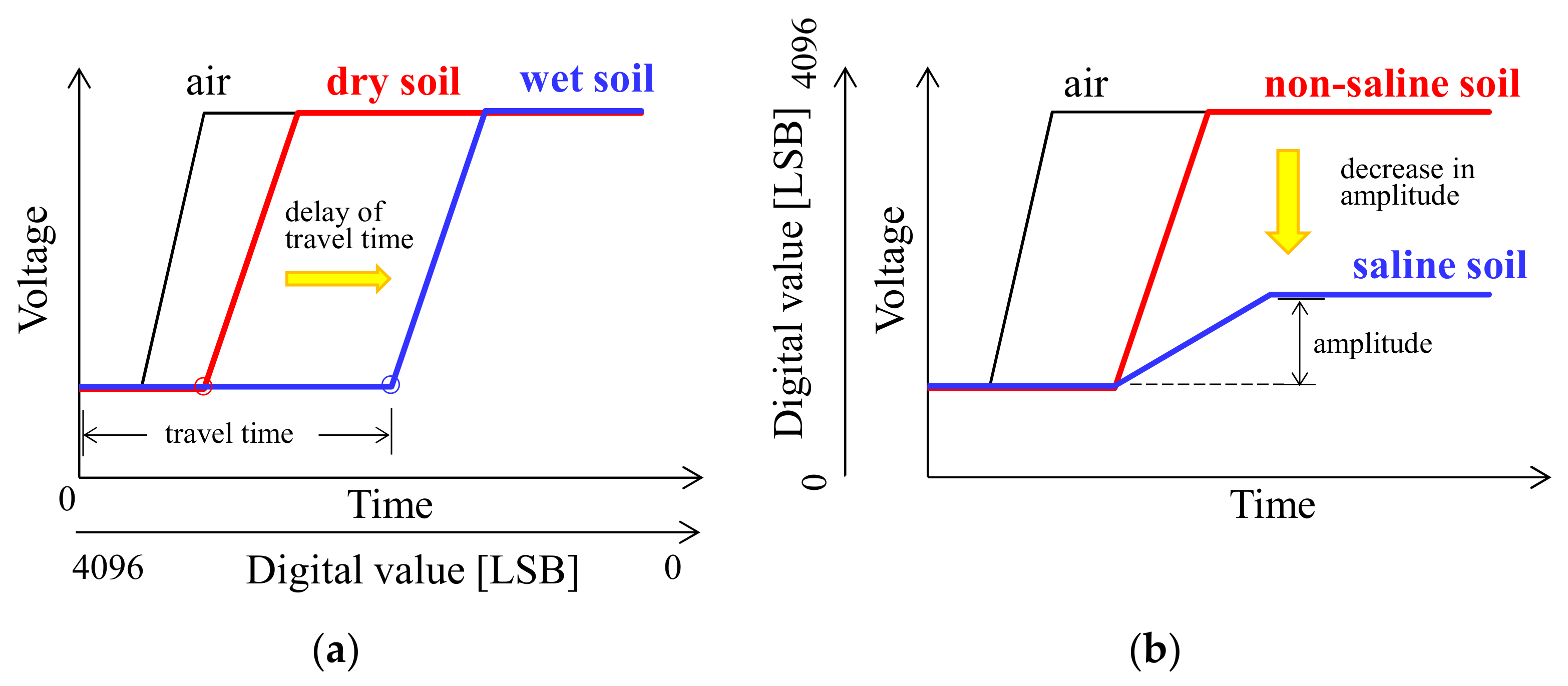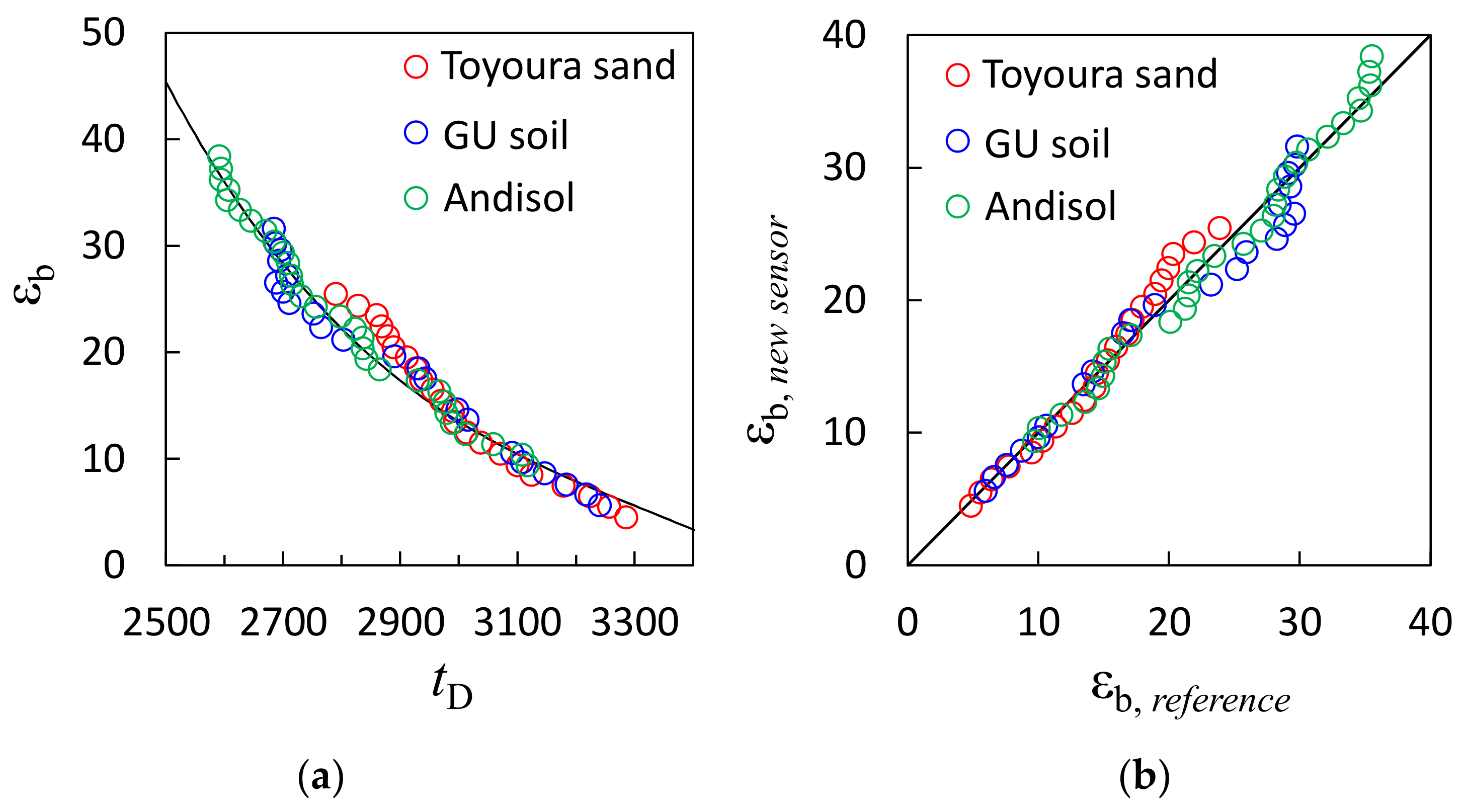Time Domain Transmissiometry-Based Sensor for Simultaneously Measuring Soil Water Content, Electrical Conductivity, Temperature, and Matric Potential
Abstract
1. Introduction
2. Materials and Methods
2.1. Sensor Development
2.2. Sensor Calibration
2.2.1. Relationship between the Sensor Outputs and the Dielectric Constant/Matric Potential
2.2.2. Relationship between Sensor Output and Electrical Conductivity
2.3. Evaluation of Temperature Dependence of Sensor Outputs
2.4. In Situ Sensor Evaluation
3. Results and Discussion
3.1. Sensor Calibration
3.1.1. Relationship between Sensor Output and Dielectric Constant
3.1.2. Relationship between Sensor Output and Matric Potential
3.1.3. Relationship between Sensor Output and Electrical Conductivity
3.2. Temperature Dependence
3.3. Field Evaluation
4. Conclusions
Author Contributions
Funding
Institutional Review Board Statement
Informed Consent Statement
Data Availability Statement
Acknowledgments
Conflicts of Interest
References
- Wolfert, S.; Ge, L.; Verdouw, C.; Bogaarrdt, M.-J. Big data in smart farming—A review. Agric. Syst. 2017, 153, 69–80. [Google Scholar] [CrossRef]
- Ritchie, J.T.; Nesmith, D.S. Temperature and crop development. In Modeling Plant and Soil Systems; Hanks, J., Ritchie, J.T., Eds.; ASA-CSSA-SSSA: Madision, WI, USA, 1991; pp. 5–29. [Google Scholar]
- Fares, A.; Alva, A.K. Evaluation of capacitance probes for optimal irrigation of citrus through soil moisture monitoring in an entisol profile. Irrig. Sci. 2000, 19, 57–64. [Google Scholar] [CrossRef]
- Vellidis, G.; Tucker, M.; Perry, C.; Kvien, C.; Bednarz, C. A real-time wireless smart sensor array for scheduling irrigation. Comput. Eectron. Agr. 2008, 61, 44–50. [Google Scholar] [CrossRef]
- Kim, Y.; Evan, R.G.; Iverson, W.M. Remote sensing and control of an irrigation system using a distributed wireless sensor network. IEEE T. Instrum. Meas. 2008, 57, 1379–1387. [Google Scholar]
- Noborio, K.; McInnes, K.J.; Heilman, J.L. Two-dimensional model for water, heat, and solute transport in furrow-irrigated soil: II. field evaluation. Soil Sci. Soc. Am. J. 1996, 60, 1010–1021. [Google Scholar] [CrossRef]
- Walczak, A.; Lipiński, M.; Janik, G. Application of the TDR sensors and the parameters of injection irrigation for the estimation of soil evaporation intensity. Sensors 2021, 21, 2309. [Google Scholar] [CrossRef]
- Coelho, E.F.; Or, D. Root distribution and water uptake patterns of corn under surface and subsurface drip irrigation. Plant Soil 1999, 206, 123–136. [Google Scholar] [CrossRef]
- Kojima, Y.; Shigeta, R.; Miyamoto, N.; Shirahama, Y.; Nishioka, K.; Mizoguchi, M.; Kawahara, Y. Low-cost soil moisture profile probe using thin-film capacitors and a capacitive touch sensor. Sensors 2016, 16, 1292. [Google Scholar] [CrossRef]
- Kizito, F.; Campbell, C.S.; Campbell, G.S.; Cobos, D.R.; Teare, B.L.; Carter, B.; Hopmans, J.W. Frequency, electrical conductivity and temperature analysis of a low-cost capacitance soil moisture sensor. J. Hydrol. 2008, 352, 367–378. [Google Scholar] [CrossRef]
- Seyfried, M.S.; Murdock, M.D. Response of a new soil water sensor to variable soil, water content, and temperature. Soil Sci. Soc. Am. J. 2001, 65, 28–34. [Google Scholar] [CrossRef]
- Corwin, D.L.; Lesch, S.M. Apparent soil electrical conductivity measurements in agriculture. Comput. Electron. Agr. 2005, 46, 11–43. [Google Scholar] [CrossRef]
- Crowin, D.L.; Lesch, S.M. Application of soil electrical conductivity to prevision agriculture: Theory, principles, and guidelines. Agron. J. 2003, 95, 455–471. [Google Scholar]
- Rhodes, J.D. Electrical conductivity methods for measuring and mapping soil salinity. Adv. Agron. 1993, 49, 201–251. [Google Scholar]
- Noborio, K. Measurement of soil water content and electrical conductivity by time domain reflectometry: A review. Comput. Electron. Agr. 2001, 31, 213–237. [Google Scholar] [CrossRef]
- Robinson, D.A.; Jones, S.B.; Wraith, J.M.; Or, D.; Friedman, S.P. A review of advances in dielectric and electrical conductivity measurement in soils using time domain reflectometry. Vadose Zone J. 2003, 2, 444–475. [Google Scholar] [CrossRef]
- Rhoades, J.D. Inexpensive four-electrode probe for monitoring soil salinity. Soil Sci. Soc. Am. J. 1979, 43, 817–818. [Google Scholar] [CrossRef]
- Konukcu, F.; Gowing, J.W.; Rose, D.A. Simple sensors to achieve fine spatial resolution in continuous measurements of soil moisture and salinity. Hydrol. Earth Syst. Sci. 2002, 6, 1043–1051. [Google Scholar] [CrossRef]
- Hillel, D. Environmental Soil Physics; Academic Press: London, UK, 1998; pp. 129–172. [Google Scholar]
- Kojima, Y.; Noborio, K.; Mizoguchi, M.; Kawahara, K. Matric potential sensor using dual probe heat pulse technique. Agr. Info. Res. 2017, 26, 77–85. [Google Scholar] [CrossRef]
- Richards, L.A. Soil moisture tensiometer materials and construction. Soil Sci. 1942, 53, 241–248. [Google Scholar] [CrossRef]
- Dabach, S.; Shani, U.; Lazarovitch, N. Optimal tensiometer placement for high-frequency subsurface drip irrigation management in heterogeneous soils. Agr. Water Manag. 2015, 152, 91–98. [Google Scholar] [CrossRef]
- Walthert, L.; Schleppi, P. Equations to compensate for the temperature effect on readings from dielectric Decagon MPS-2 and MPS-6 water potential sensors in soils. J. Plant Nutr. Soil Sci. 2018, 181, 749–759. [Google Scholar] [CrossRef]
- Da Mota, W.N.; Evangelista, A.W.P.; Maia, L.J.Q.; Correchel, V.; Alves, J.; Varrone, L.F.R.; de F.N. Gitirana, G., Jr. Development of a heat pulse sensor for measuring matric suction on soilless substrates. Comput. Electron. Agr. 2021, 185, 106119. [Google Scholar] [CrossRef]
- Or, D.; Wraith, J.M. A new soil matric potential sensor based on time domain reflectometry. Water Resour. Res. 1999, 35, 3399–3407. [Google Scholar] [CrossRef]
- Noborio, K.; Horton, R.; Tan, C.S. Time domain reflectometry probe for simultaneous measurement of soil matric potential and water content. Soil Sci. Soc. Am. J. 1999, 63, 1500–1505. [Google Scholar] [CrossRef]
- Vaz, C.M.P.; Hopmans, J.W.; Macedo, A.; Bassoi, L.H.; Wildenschild, D. Soil water retention measurements using a combined tensiometer-coiled time domain reflectometry probe. Soil Sci. Soc. Am. J. 2002, 66, 1752–1759. [Google Scholar] [CrossRef]
- Kojima, Y.; Kawashima, T.; Noborio, K.; Kamiya, K.; Horton, R. A dual-probe heat pulse-based sensor that simultaneously determine soil thermal properties, soil water content and soil water matric potential. Comput. Electron. Agr. 2021, 188, 106331. [Google Scholar] [CrossRef]
- Campbell, G.S.; Calissendorff, C.; Williams, J.H. Probe for measuring soil specific heat using a heat-pulse method. Soil Sci. Soc. Am. J. 1991, 55, 291–293. [Google Scholar] [CrossRef]
- Bristow, K.L.; Kluitenberg, G.J.; Horton, R. Measurement of soil thermal properties with a dual-probe heat-pulse technique. Soil Sci. Soc. Am. J. 1994, 58, 1288–1294. [Google Scholar] [CrossRef]
- Topp, G.C.; Lapen, D.R.; Edwards, M.J.; Young, G.D. Laboratory calibration, in-field validation and use of a soil penetrometer measuring cone resistance and water content. Vadose Zone J. 2003, 2, 633–641. [Google Scholar] [CrossRef]
- Miyamoto, H.; Ito, N.; Yasunaga, E.; Takaichi, S.; Mase, A.; Chikushi, J. Measurement of dielectric properties using time domain transmissiometry (TDT) with broad band impulse-signal. J. Jpn. Soc. Soil Phys. 2008, 110, 3–12. (In Japanese) [Google Scholar]
- Harlow, R.C.; Burke, E.J.; Ferré, T.P.A.; Bennett, J.C.; Shuttleworth, W.J. Measuring spectral dielectric properties using gated time domain transmission measurements. Vadose Zone J. 2003, 2, 424–432. [Google Scholar] [CrossRef]
- Miyamoto, H.; Ito, N.; Mase, A.; Tokumoto, I.; Chikushi, J. Application of time domain transmissiometry to coupled measurements of soil moisture and electrical conductivity. IDRE Journal 2013, 288, 25–31. (In Japanese) [Google Scholar]
- Blonquist, J.M.; Jones, S.B.; Robinson, D.A. A time domain transmission sensor with TDR performance characteristics. J. Hydrol. 2005, 314, 235–245. [Google Scholar] [CrossRef]
- Topp, G.C.; Davis, J.L.; Annan, A.P. Electromagnetic determination of soil water content: Measurements in coaxial transmission lines. Water Resour. Res. 1980, 16, 574–582. [Google Scholar] [CrossRef]
- Miyamoto, T.; Kobayashi, R.; Annaka, T.; Chikushi, J. Applicability of multiple length TDR probes to measure water distributions in and Andisol under different tillage systems in Japan. Soil Till. Res. 2001, 60, 91–99. [Google Scholar] [CrossRef]
- Hilhorst, M.A. A pore water conductivity sensor. Soil Sci. Soc. Am. J. 2000, 64, 1922–1925. [Google Scholar] [CrossRef]
- Van Genuchten, M.T. A closed-form equation for predicting the hydraulic conductivity of unsaturated soils. Soil Sci. Soc. Am. J. 1980, 44, 892–898. [Google Scholar] [CrossRef]
- Jones, S.B.; Or, D. Frequency domain analysis for extending time domain reflectometry water content measurement in highly saline soils. Soil Sci. Soc. Am. J. 2004, 68, 1568–1577. [Google Scholar] [CrossRef]
- Zemni, N.; Bouksila, F.; Slama, F.; Persson, M.; Berndtsson, R.; Bouhlila, R. Evaluation of modified Hilhorst models for pore electrical conductivity estimation using a low-cost dielectric sensor. Arab. J. Geosci. 2022, 15, 1089. [Google Scholar] [CrossRef]
- Miyamoto, T.; Annaka, T.; Chikushi, J. Extended dual composite sphere model for determining dielectric permittivity of Andisols. Soil Sci. Soc. Am. J. 2005, 69, 23–29. [Google Scholar] [CrossRef]
- Wraith, J.M.; Or, D. Temperature effects on soil bulk dielectric permittivity measured by time domain reflectometry: Experimental evidence and hypothesis development. Water Resour. Res. 1999, 35, 361–369. [Google Scholar] [CrossRef]
- Bordoni, M.; Bittelli, M.; Valentino, R.; Chersich, S.; Meisina, C. Improving the estimation of complete field soil water characteristic curves through field monitoring data. J. Hydrol. 2017, 552, 283–305. [Google Scholar] [CrossRef]








| % Sand | % Silt | % Clay | SOM Content (kg kg−1) | Bulk Density (kg m−3) | Hydraulic Conductivity (m s−1) | |
|---|---|---|---|---|---|---|
| Toyoura sand | 100.0 | 0.0 | 0.0 | 0.00 | 1340 | 1.2 × 10−4 |
| GU soil | 61.7 | 16.1 | 22.2 | 0.07 | 1080 | 1.5 × 10−5 |
| Andisol | 66.3 | 27.5 | 6.2 | 0.23 | 820 | 4.5 × 10−6 |
| CD,max | CD,min | α (kPa−1) | n | |
|---|---|---|---|---|
| GU soil | 1357 | 715 | 0.086 | 2.32 |
| Andisol | 1415 | 743 | 0.100 | 2.11 |
| All plots | 1415 | 715 | 0.105 | 2.04 |
Disclaimer/Publisher’s Note: The statements, opinions and data contained in all publications are solely those of the individual author(s) and contributor(s) and not of MDPI and/or the editor(s). MDPI and/or the editor(s) disclaim responsibility for any injury to people or property resulting from any ideas, methods, instructions or products referred to in the content. |
© 2023 by the authors. Licensee MDPI, Basel, Switzerland. This article is an open access article distributed under the terms and conditions of the Creative Commons Attribution (CC BY) license (https://creativecommons.org/licenses/by/4.0/).
Share and Cite
Kojima, Y.; Matsuoka, M.; Ariki, T.; Yoshioka, T. Time Domain Transmissiometry-Based Sensor for Simultaneously Measuring Soil Water Content, Electrical Conductivity, Temperature, and Matric Potential. Sensors 2023, 23, 2340. https://doi.org/10.3390/s23042340
Kojima Y, Matsuoka M, Ariki T, Yoshioka T. Time Domain Transmissiometry-Based Sensor for Simultaneously Measuring Soil Water Content, Electrical Conductivity, Temperature, and Matric Potential. Sensors. 2023; 23(4):2340. https://doi.org/10.3390/s23042340
Chicago/Turabian StyleKojima, Yuki, Manabu Matsuoka, Tomohide Ariki, and Tetsuo Yoshioka. 2023. "Time Domain Transmissiometry-Based Sensor for Simultaneously Measuring Soil Water Content, Electrical Conductivity, Temperature, and Matric Potential" Sensors 23, no. 4: 2340. https://doi.org/10.3390/s23042340
APA StyleKojima, Y., Matsuoka, M., Ariki, T., & Yoshioka, T. (2023). Time Domain Transmissiometry-Based Sensor for Simultaneously Measuring Soil Water Content, Electrical Conductivity, Temperature, and Matric Potential. Sensors, 23(4), 2340. https://doi.org/10.3390/s23042340






